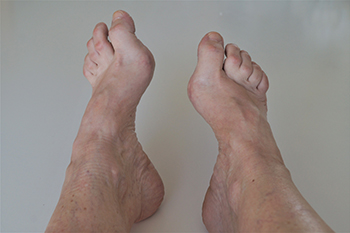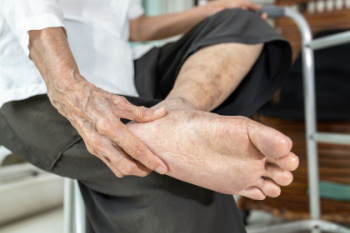
The arch of the foot is essential for supporting weight and movement, but high arches can lead to various issues. Identifying high arches can be done through methods like the wet footprint test or medical evaluation by a podiatrist. Problems associated with high arches include plantar fasciitis, metatarsalgia, claw toes, and hammer toe. Foot and ankle instability, often stemming from altered walking patterns and increased pressure, may also be the result of high arches. Custom orthotic devices, and wearing specialized shoes can offer relief. In severe cases, surgical intervention may be needed to enhance foot stability. A podiatrist can conduct a thorough examination and determine the appropriate treatment options. To correct foot problems brought on by high arches, it is suggested that you schedule an appointment with a podiatrist.
If you have any concerns about your feet, contact Milos Tomich, DPM from Dr. Tomich Foot & Ankle Health Center. Our doctor can provide the care you need to keep you pain-free and on your feet.
Biomechanics in Podiatry
Podiatric biomechanics is a particular sector of specialty podiatry with licensed practitioners who are trained to diagnose and treat conditions affecting the foot, ankle and lower leg. Biomechanics deals with the forces that act against the body, causing an interference with the biological structures. It focuses on the movement of the ankle, the foot and the forces that interact with them.
A History of Biomechanics
- Biomechanics dates back to the BC era in Egypt where evidence of professional foot care has been recorded.
- In 1974, biomechanics gained a higher profile from the studies of Merton Root, who claimed that by changing or controlling the forces between the ankle and the foot, corrections or conditions could be implemented to gain strength and coordination in the area.
Modern technological improvements are based on past theories and therapeutic processes that provide a better understanding of podiatric concepts for biomechanics. Computers can provide accurate information about the forces and patterns of the feet and lower legs.
Understanding biomechanics of the feet can help improve and eliminate pain, stopping further stress to the foot.
If you have any questions please feel free to contact one of our offices located in Milwaukee and Wauwatosa, WI . We offer the newest diagnostic and treatment technologies for all your foot and ankle needs.
 Tarsal tunnel syndrome, which involves the compression of the posterior tibial nerve as it passes through the tarsal tunnel on the inner side of the ankle, can be tricky to diagnose. Diagnosis typically begins with a physical examination where a podiatrist, or foot doctor, evaluates the foot for signs of nerve compression. The podiatrist may use specific tests that could provoke symptoms. To confirm the diagnosis and eliminate other potential conditions, magnetic resonance Imaging, or an MRI scan is commonly used. An MRI can provide clear images of the soft tissues surrounding the ankle, helping to identify any abnormalities like tumors, varicose veins, or structural deformities compressing the nerve. The treatment strategy may vary depending on MRI findings. For example, if the MRI reveals a structural anomaly compressing the nerve, surgical intervention may be required to alleviate the pressure. However, if inflammation is mild and no significant anatomical issues are detected, more conservative treatments like corticosteroid injections or custom orthotics might be effective. For proper diagnosis of tarsal tunnel syndrome and the most effective treatment plan, it is suggested that you consult a podiatrist.
Tarsal tunnel syndrome, which involves the compression of the posterior tibial nerve as it passes through the tarsal tunnel on the inner side of the ankle, can be tricky to diagnose. Diagnosis typically begins with a physical examination where a podiatrist, or foot doctor, evaluates the foot for signs of nerve compression. The podiatrist may use specific tests that could provoke symptoms. To confirm the diagnosis and eliminate other potential conditions, magnetic resonance Imaging, or an MRI scan is commonly used. An MRI can provide clear images of the soft tissues surrounding the ankle, helping to identify any abnormalities like tumors, varicose veins, or structural deformities compressing the nerve. The treatment strategy may vary depending on MRI findings. For example, if the MRI reveals a structural anomaly compressing the nerve, surgical intervention may be required to alleviate the pressure. However, if inflammation is mild and no significant anatomical issues are detected, more conservative treatments like corticosteroid injections or custom orthotics might be effective. For proper diagnosis of tarsal tunnel syndrome and the most effective treatment plan, it is suggested that you consult a podiatrist.
Tarsal tunnel syndrome can be very uncomfortable to live with. If you are experiencing tarsal tunnel syndrome, contact Milos Tomich, DPM of Dr. Tomich Foot & Ankle Health Center. Our doctor can provide the care you need to keep you pain-free and on your feet.
Tarsal Tunnel Syndrome
Tarsal tunnel syndrome, which can also be called tibial nerve dysfunction, is an uncommon condition of misfiring peripheral nerves in the foot. The tibial nerve is the peripheral nerve in the leg responsible for sensation and movement of the foot and calf muscles. In tarsal tunnel syndrome, the tibial nerve is damaged, causing problems with movement and feeling in the foot of the affected leg.
Common Cause of Tarsal Tunnel Syndrome
- Involves pressure or an injury, direct pressure on the tibial nerve for an extended period of time, sometimes caused by other body structures close by or near the knee.
- Diseases that damage nerves, including diabetes, may cause tarsal tunnel syndrome.
- At times, tarsal tunnel syndrome can appear without an obvious cause in some cases.
The Effects of Tarsal Tunnel Syndrome
- Different sensations, an afflicted person may experience pain, tingling, burning or other unusual sensations in the foot of the affected leg.
- The foot muscles, toes and ankle become weaker, and curling your toes or flexing your foot can become difficult.
- If condition worsens, infections and ulcers may develop on the foot that is experiencing the syndrome.
A physical exam of the leg can help identify the presence of tarsal tunnel syndrome. Medical tests, such as a nerve biopsy, are also used to diagnose the condition. Patients may receive physical therapy and prescriptive medication. In extreme cases, some may require surgery.
If you have any questions please feel free to contact one of our offices located in Milwaukee and Wauwatosa, WI . We offer the newest diagnostic and treatment technologies for all your foot and ankle needs.
 Ingrown toenails are among the most common and painful foot issues people face. An ingrown toenail occurs when the edge or corner of the toenail grows into the surrounding skin, causing irritation, redness, swelling, and pain. If left untreated, ingrown toenails can become infected, leading to more severe discomfort and potentially serious complications. Podiatrists, or foot doctors, specialize in treating ingrown toenails and offer effective solutions to alleviate the pain associated with this condition. When you visit a podiatrist for an infected ingrown toenail, they will first assess the severity of the problem. Targeted treatment typically involves gently trimming or removing the ingrown portion of the nail, along with providing relief for any associated infection. Podiatrists can also offer guidance on proper nail care techniques to help prevent future occurrences. If you're dealing with the discomfort of an ingrown toenail, it is suggested that you schedule an appointment with a podiatrist.
Ingrown toenails are among the most common and painful foot issues people face. An ingrown toenail occurs when the edge or corner of the toenail grows into the surrounding skin, causing irritation, redness, swelling, and pain. If left untreated, ingrown toenails can become infected, leading to more severe discomfort and potentially serious complications. Podiatrists, or foot doctors, specialize in treating ingrown toenails and offer effective solutions to alleviate the pain associated with this condition. When you visit a podiatrist for an infected ingrown toenail, they will first assess the severity of the problem. Targeted treatment typically involves gently trimming or removing the ingrown portion of the nail, along with providing relief for any associated infection. Podiatrists can also offer guidance on proper nail care techniques to help prevent future occurrences. If you're dealing with the discomfort of an ingrown toenail, it is suggested that you schedule an appointment with a podiatrist.
Ingrown toenails may initially present themselves as a minor discomfort, but they may progress into an infection in the skin without proper treatment. For more information about ingrown toenails, contact Milos Tomich, DPM of Dr. Tomich Foot & Ankle Health Center. Our doctor can provide the care you need to keep you pain-free and on your feet.
Ingrown Toenails
Ingrown toenails are caused when the corner or side of a toenail grows into the soft flesh surrounding it. They often result in redness, swelling, pain, and in some cases, infection. This condition typically affects the big toe and may recur if it is not treated properly.
Causes
- Improper toenail trimming
- Genetics
- Improper shoe fitting
- Injury from pedicures or nail picking
- Abnormal gait
- Poor hygiene
You are more likely to develop an ingrown toenail if you are obese, have diabetes, arthritis, or have any fungal infection in your nails. Additionally, people who have foot or toe deformities are at a higher risk of developing an ingrown toenail.
Symptoms
Some symptoms of ingrown toenails are redness, swelling, and pain. In rare cases, there may be a yellowish drainage coming from the nail.
Treatment
Ignoring an ingrown toenail can have serious complications. Infections of the nail border can progress to a deeper soft-tissue infection, which can then turn into a bone infection. You should always speak with your podiatrist if you suspect you have an ingrown toenail, especially if you have diabetes or poor circulation.
If you have any questions, please feel free to contact one of our offices located in Milwaukee and Wauwatosa, WI . We offer the newest diagnostic and treatment technologies for all your foot care needs.








